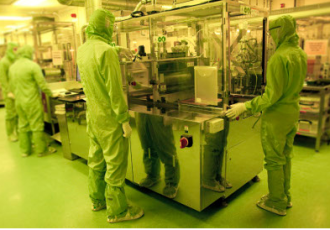 Some call it the internet of things (IoT), some call it the internet of everything (IoE) and some even call it the internet of fangs (IoF).
Some call it the internet of things (IoT), some call it the internet of everything (IoE) and some even call it the internet of fangs (IoF).
 Some call it the internet of things (IoT), some call it the internet of everything (IoE) and some even call it the internet of fangs (IoF).
Some call it the internet of things (IoT), some call it the internet of everything (IoE) and some even call it the internet of fangs (IoF).
 A company based in Cambridge claimed that by the end of this year it will produce properly flexible displays by the end of this year.
A company based in Cambridge claimed that by the end of this year it will produce properly flexible displays by the end of this year.
 Although there’s still a clear lack of standards with different vendors vying to take the lead, many organisations are getting ready for the internet of things (IoT).
Although there’s still a clear lack of standards with different vendors vying to take the lead, many organisations are getting ready for the internet of things (IoT).
 Giant US microprocessor combine Intel has paid an unknown amount of money to snap up a Germany chip company.
Giant US microprocessor combine Intel has paid an unknown amount of money to snap up a Germany chip company.
 Chip giant Intel is being stubborn about its mobile strategy and will continue to throw money at the problem.
Chip giant Intel is being stubborn about its mobile strategy and will continue to throw money at the problem.
 An estimate by Gartner analysts predicts that connected kitchens are going to save us 15 percent by 2020.
An estimate by Gartner analysts predicts that connected kitchens are going to save us 15 percent by 2020.
 The Linux OS maker Canonical wants to extend its Ubuntu Snappy Linux technology to power the Internet of Things.
The Linux OS maker Canonical wants to extend its Ubuntu Snappy Linux technology to power the Internet of Things.
Ubuntu is best known as a popular Linux operating system for servers, cloud and desktops. Now Canonical is tweaking Ubuntu to power embedded devices and IoT.
The key to this is apparently the Snappy Ubuntu Core technology. Snappy Ubuntu Core was first announced on December 10, 2014, as a cut down version of Ubuntu.
Snappy was supposed to be a cloud technology but has been seen as a wizard thing to run embedded devices.
Mark Shuttleworth, founder of Ubuntu and Canonical, said that the use of Snappy could improve the security, reliability, and efficiency of update mechanisms and help to isolate apps from one another.
This fixes a problem with IoT that its operating systems are harder to upgrade – which makes them insecure.
Shuttleworth said that Snappy updates can be delivered as smaller, more efficient transactional updates. It also has an update rollback feature, which can enable an application to be reverted if the update is unsuccessful for some reason.
He said that Snappy has very efficient bandwidth usage, making it ideal for IoT embedded devices. With
Shuttleworth told eWeek that Canonical could deliver an update for something like a Heartbleed or Shellshock vulnerability, completely independently of the lawnmower control app that would come from the lawnmower company.
With IoT, anything and everything can be connected to the Internet, even potentially a lawnmower, and it is usually up to the vendor to provide patches for any security issues.
To help capitalize on the IoT opportunity, Canonical now has an entire Internet of things division within the company.
While it sounds grandiose that we have a whole Internet of things division, this is an extremely efficient repurposing of the technology we already have,” Shuttleworth said.
 The growth of devices with internet protocol (IP) capabilities will generate a boom in big data and analytics revenue.
The growth of devices with internet protocol (IP) capabilities will generate a boom in big data and analytics revenue.
 While high prices have prevented municipal authorities from investing in “clever” street lights, that’s starting to change.
While high prices have prevented municipal authorities from investing in “clever” street lights, that’s starting to change. Guy Churchward, head of EMC’s $20-billion core technologies division, has warned that small data is going to cause even bigger headaches than the big stuff.
Guy Churchward, head of EMC’s $20-billion core technologies division, has warned that small data is going to cause even bigger headaches than the big stuff.
Taking to the Economic Times Churchward said that data challenges for the Internet of Things or driverless cars were huge,
He said that millions of driverless cars, and billions of other internetconnected devices will not be Big Data. “What you have is not big data, it is actually `small data’ – because what it is, is billions and billions of small data objects.”
EMC expects IoT to create a sprawl of billions of autonomous devices, which will create security, storage and management nightmares in future.
Churchward warned that “small data sprawl” will take the challenges of Big Data and make them 100x more difficult.
Security, storage, management and applications would be completely different in a world filled with billions of devices, each of which will have its own big data. None of the currently available tools and applications would work in such environments.
Part of EMC’s over $2.3-billion research and development budget is being used to address this `small data’ problem but the company thinks that it will take between three to five years to start bearing fruit.
 While Intel is pinning its future on the Internet of Things (IoT), AMD appears to be spurning it as if it were a rabid dog.
While Intel is pinning its future on the Internet of Things (IoT), AMD appears to be spurning it as if it were a rabid dog.
Its senior vice president and general manager of the computing and graphics business group John Byrne thinks that it is much wiser to keep pushing into the PC market, which is still a $40-billion-a-year opportunity.
Talking to Venture Beat he said that AMD has to execute on its upcoming Carrizo family of accelerated processing units (APUs), which will be focused on the mobile computing market. About 300 million PC processors and 90 million graphics chips are sold each year, and Byrne wants AMD to get its fair share of those sales.
Byrne thinks that setting up a chip making operation for the Internet of Things is just an invitation to lose money.
Byrne said while it concentrated on the IoT, Intel it was missing opportunities in the classic PC market.
“There’s still 300 million PCs, still 90 million graphics chips. If I look at Intel, Nvidia, and my revenue, that’s still a $40 billion market — even before you get to the IoT. If you look at the gross margin profile of that business, it’s still significantly more than AMD as a company’s average. There’s still significant market opportunities in the classic PC space,” Byrne said.
He said that AMD still had work to do in the PC chip market. It had to work on its x86 performance, ensuring that each product it bought to market is better x86. There needed to be improvements in graphics, notebooks needed to improve battery life.
Byrne said that it all meant that AMD could push into the commercial market a long more. He pointed out that AMD won the industry’s largest single tender in commercial 18 months ago in India and Elitebook with HP last year.
“Wait until you see the lineup of commercial platforms I have with Carrizo. It allows us to continue to attack that i3, attack that i5 consumer, and really get to penetrate the commercial market space. We’ll attack graphics. That’s going to be my strategy next, he said.
While he said that the Internet of Things is important there are two ways to make cash from it. Intel is concentrating on the silicon inside the wearable. However, that will cost under $10 and not make huge amounts of cash.
“You’re seeing that with Quark and some of the other investments our competitors are making. I’m not in business to lose money. Share and revenue is nice but so is profitability,” he said.
But all of those devices have to be connected and it is those higher end devices that AMD will be targeting.
 At the CES show at Las Vegas this week, Intel Chief Executive Brian Krzanich showed off a computer built into a jacket button and a wristband that transforms into a selfie-snapping flying camera drone.
At the CES show at Las Vegas this week, Intel Chief Executive Brian Krzanich showed off a computer built into a jacket button and a wristband that transforms into a selfie-snapping flying camera drone.
It says a lot about where Intel sees the future of computing. Gone are the days of number crunching business computers, instead the world’s chip makers are developing gadgets which are better at photographing their own users.
Already tourist destinations are full of people carrying their phones on sticks so that they can take snaps of themselves at famous monuments without needing a friend. Now it seems that Intel sees a future for machines that can take pictures of bald heads at famous monuments while at the same time navigating through a sea of Japanese drones re-enacting a narcissistic battle of Midway on the Spanish Steps.
Krzanich used most of his keynote to talk up Intel’s efforts in computerised apparel and other sensor-packed gadgets as consumers get bored with their tablets and start selling their kidneys for the next shiny thing.
Curie, a new button-sized computer for smart clothes, is due out later in 2015 and includes Bluetooth radio as well as the latest from Intel’s Quark line of low-power chips. However Krzanich did sound a little like an East End market barrow boy when he talked about “rings, bags, bracelets, pendants, and yes, even the buttons on our jackets.” They are not dodgy, not dodgy.
Intel is working with Oakley to launch a smart gadget for athletes later this year, Krzanich said. The chipmaker in December announced it was developing smart glasses with Luxottica, which owns the Oakley brand.
Krazanich also said that he was spending $300 million to get more women and minorities in the technology and the video game industries. Note that money will be spent training women and minorities, there is no guarantee that Intel or any other technology company will hire them.
Intel has a poor record of accomplishment employing women and some minorities. While it is happy to hire Chinese and Indian workers, because they are nice and cheap, only a quarter of Intel’s US employees in 2013 were women and 12 percent of its workforce were Hispanic or African American.
Last year Intel made a huge mistake by backing the misogynistic GamerGate campaign to pull advertising from gaming news sites who dared to slam sexism in the gaming industry. In the end it changed its mind and resumed advertising.
 The CEO of Samsung has made a bid for his company to become an active player in the internet of things (IoT) by putting uo funding for developers.
The CEO of Samsung has made a bid for his company to become an active player in the internet of things (IoT) by putting uo funding for developers.
 Comms company Belkin is using the Consumer Electronics Show (CES) in Las Vegas this week to demonstrate a range of products that promise to make peoples’ homes more secure.
Comms company Belkin is using the Consumer Electronics Show (CES) in Las Vegas this week to demonstrate a range of products that promise to make peoples’ homes more secure. Vuzix has told the world+dog that the small time chipmaker Intel has invested $24.8 million in the company to speed up the launch of its internet-connected specs.
Vuzix has told the world+dog that the small time chipmaker Intel has invested $24.8 million in the company to speed up the launch of its internet-connected specs.
Intel bought preferred stock that is convertible into common shares equivalent to 30 percent of Vuzix, Vuzix said in a press release.
New York-based Vuzix develops computerised, internet-connected glasses and other video eyewear aimed at consumers, businesses and entertainment. Intel is dead keen to get its foot in the door of such market having been too late into the smartphones and tablets fad.
It is the second big deal to be announced in a month. In December, Italy’s Luxottica said it was joining forces with the US chipmaker to develop glasses that combine its top fashion brands with technology that could allow wearers to access information about their health or location.
Intel has also teamed up with watch retailer Fossil and fashion brand Opening Ceremony to develop wearable devices such as fashion bracelets with communications features and wireless charging.
It is all early days yet, but it seems that Intel is preparing the ground.